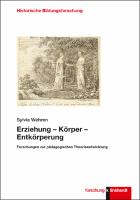Erziehung – Körper – Entkörperung
Forschungen zur pädagogischen Theorieentwicklung
| dc.contributor.author | Wehren, Sylvia | |
| dc.date.accessioned | 2021-10-22T09:52:19Z | |
| dc.date.available | 2021-10-22T09:52:19Z | |
| dc.date.issued | 2020 | |
| dc.identifier | ONIX_20211022_9783781523876_9 | |
| dc.identifier | OCN: 1303503585 | |
| dc.identifier.uri | https://library.oapen.org/handle/20.500.12657/51140 | |
| dc.description.abstract | The historical and theoretical relationship between education and the body is the focus of this discourse-analytical study. It is situated at the interface of systematic educational science and historical educational research and looks at both the current debate on educational theory and the pedagogical discussions at the end of the 18th century and the beginning of the 19th century. The starting point of the analyses is a theoretical phenomenon called disembodiment. This term refers to different dynamics that in their totality aim at the discursive exclusion and marginalisation of corporeality in the discourse on education. Three works from different currents of pedagogy are examined more closely for this purpose: Campe's 'Allgemeine Revision des gesammten Schul- und Erziehungswesens' (1785-1792), Niemeyer's 'Grundsätze der Erziehung und des Unterrichts' (1796-1824/5) and two writings by Schwarz, the 'Erziehungslehre' (1802-1813) and the 'Lehrbuch der Erziehung und Unterrichtslehre' (1805-1835). In addition to a presentation of the spectrum of perspectives on physical education, a reconstruction of the historical discourse of so-called physical education and case analyses of the anthropological contexts, the study is able to show that disembodiment tendencies can be traced not only in the current discourse, but already at the turn of the 19th century. | |
| dc.language | German | |
| dc.relation.ispartofseries | Historische Bildungsforschung | |
| dc.subject.classification | thema EDItEUR::J Society and Social Sciences::JN Education | en_US |
| dc.subject.other | Historische Bildungsforschung | |
| dc.subject.other | Erziehungswissenschaft | |
| dc.subject.other | Körper <Biol> | |
| dc.subject.other | Körperlichkeit | |
| dc.subject.other | Leiblichkeit | |
| dc.subject.other | Menschlicher Körper | |
| dc.subject.other | Pädagogische Theorie | |
| dc.subject.other | Bildungstheorie | |
| dc.subject.other | Erziehung | |
| dc.subject.other | Geschichte <Histor> | |
| dc.subject.other | Diskursanalyse | |
| dc.subject.other | Historische Analyse | |
| dc.subject.other | Campe, Joachim Heinrich | |
| dc.subject.other | Niemeyer, August Hermann | |
| dc.subject.other | Schwarz, Friedrich Heinrich Christian | |
| dc.subject.other | 18. Jahrhundert | |
| dc.subject.other | 19. Jahrhundert | |
| dc.subject.other | Dissertationsschrift | |
| dc.subject.other | Deutschland | |
| dc.subject.other | Sciences of education | |
| dc.subject.other | Corporeality | |
| dc.subject.other | Corporealtity | |
| dc.subject.other | Human body | |
| dc.subject.other | Pedagogical theory | |
| dc.subject.other | Educational theory | |
| dc.subject.other | Theory of education | |
| dc.subject.other | Education | |
| dc.subject.other | History | |
| dc.subject.other | Discourse Analysis | |
| dc.subject.other | Historical analysis | |
| dc.subject.other | Doctoral Theses | |
| dc.subject.other | Germany | |
| dc.title | Erziehung – Körper – Entkörperung | |
| dc.title.alternative | Forschungen zur pädagogischen Theorieentwicklung | |
| dc.type | book | |
| oapen.abstract.otherlanguage | Das geschichtliche sowie theoretische Verhältnis von Erziehung und Körper steht im Zentrum dieser diskursanalytisch angelegten Studie. Diese ist an der Schnittstelle von systematischer Erziehungswissenschaft und historischer Bildungsforschung angesiedelt und betrachtet sowohl die aktuelle erziehungstheoretische Debatte als auch die pädagogischen Diskussionen am Ende des 18. und zu Beginn des 19. Jahrhunderts. Ausgangspunkt der Analysen ist ein theoretisches Phänomen, das als Entkörperung bezeichnet wird. Mit diesem Begriff sind unterschiedliche Dynamiken gemeint, die in ihrer Gesamtheit auf die diskursive Ausgrenzung und Marginalisierung von Körperlichkeit in der Rede über Erziehung zielen. Drei Werke aus unterschiedlichen Strömungen der Pädagogik sind hierfür näher untersucht: Die von Campe herausgegebene ‚Allgemeine Revision des gesammten Schul- und Erziehungswesens‘ (1785–1792), die ‚Grundsätze der Erziehung und des Unterrichts‘ (1796–1824/5) von Niemeyer und zwei Schriften von Schwarz, die ‚Erziehungslehre‘ (1802–1813) sowie das ‚Lehrbuch der Erziehung und Unterrichtslehre‘ (1805–1835). Neben einer Darstellung des Spektrums der körperpädagogischen Perspektiven, einer Rekonstruktion des historischen Diskurses der sogenannten physischen Erziehung und Fallanalysen zu den anthropologischen Kontexten, kann die Untersuchung im Ergebnis zeigen, dass nicht nur im aktuellen Diskurs, sondern bereits an der Wende zum 19. Jahrhundert Entkörperungstendenzen nachzuweisen sind. (DIPF/Orig.) | |
| oapen.identifier.doi | 10.35468/5824 | |
| oapen.relation.isPublishedBy | 9a084ee3-3f86-4be2-81d6-89c9fbc5f173 | |
| oapen.relation.isbn | 9783781523876 | |
| oapen.relation.isbn | 9783781558243 | |
| oapen.pages | 271 | |
| oapen.place.publication | Bad Heilbrunn |

